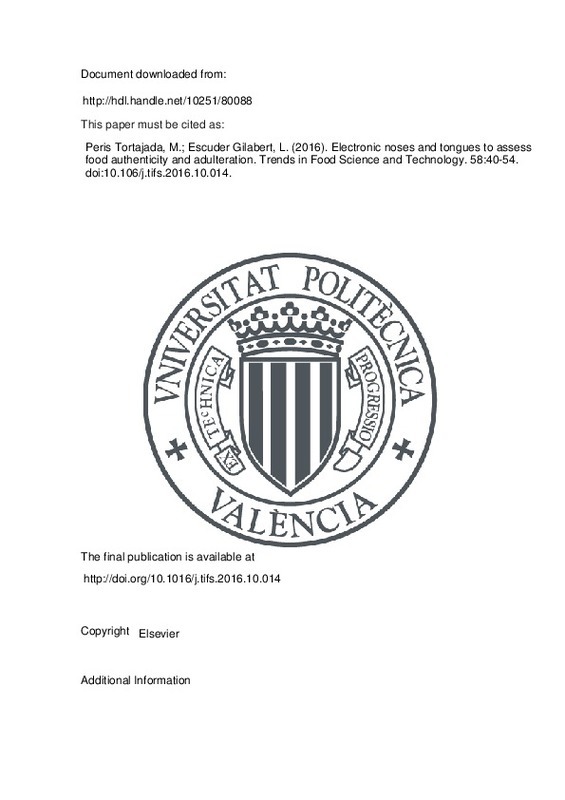JavaScript is disabled for your browser. Some features of this site may not work without it.
Buscar en RiuNet
Listar
Mi cuenta
Estadísticas
Ayuda RiuNet
Admin. UPV
Electronic noses and tongues to assess food authenticity and adulteration
Mostrar el registro sencillo del ítem
Ficheros en el ítem
| dc.contributor.author | Peris Tortajada, Miguel
|
es_ES |
| dc.contributor.author | Escuder Gilabert, Laura
|
es_ES |
| dc.date.accessioned | 2017-04-27T07:29:59Z | |
| dc.date.available | 2017-04-27T07:29:59Z | |
| dc.date.issued | 2016-12 | |
| dc.identifier.issn | 0924-2244 | |
| dc.identifier.uri | http://hdl.handle.net/10251/80088 | |
| dc.description.abstract | [EN] Background: There is a growing concern for the problem of food authenticity assessment (and hence the detection of food adulteration), since it cheats the consumer and can pose serious risk to health in some instances. Unfortunately, food safety/integrity incidents occur with worrying regularity, and therefore there is clearly a need for the development of new analytical techniques. Scope and approach: In this review, after briefly commenting the principles behind the design of electronic noses and electronic tongues, the most relevant contributions of these sensor systems in food adulteration control and authenticity assessment over the past ten years are discussed. It is also remarked that future developments in the utilization of advanced sensors arrays will lead to superior electronic senses with more capabilities, thus making the authenticity and falsification assessment of food products a faster and more reliable process. Key findings and conclusions: The use of both types of e-devices in this field has been steadily increasing along the present century, mainly due to the fact that their efficiency has been significantly improved as important developments are taking place in the area of data handling and multivariate data analysis methods. (C) 2016 Elsevier Ltd. All rights reserved. | es_ES |
| dc.language | Inglés | es_ES |
| dc.publisher | Elsevier | es_ES |
| dc.relation.ispartof | Trends in Food Science and Technology | es_ES |
| dc.rights | Reconocimiento - No comercial - Sin obra derivada (by-nc-nd) | es_ES |
| dc.subject | Electronic nose | es_ES |
| dc.subject | Electronic tongue | es_ES |
| dc.subject | Food adulteration | es_ES |
| dc.subject | Authenticity assessment | es_ES |
| dc.subject | Food analysis | es_ES |
| dc.subject.classification | QUIMICA ANALITICA | es_ES |
| dc.title | Electronic noses and tongues to assess food authenticity and adulteration | es_ES |
| dc.type | Artículo | es_ES |
| dc.identifier.doi | 10.106/j.tifs.2016.10.014 | |
| dc.rights.accessRights | Abierto | es_ES |
| dc.contributor.affiliation | Universitat Politècnica de València. Escuela Técnica Superior de Ingeniería Agronómica y del Medio Natural - Escola Tècnica Superior d'Enginyeria Agronòmica i del Medi Natural | es_ES |
| dc.description.bibliographicCitation | Peris Tortajada, M.; Escuder Gilabert, L. (2016). Electronic noses and tongues to assess food authenticity and adulteration. Trends in Food Science and Technology. 58:40-54. doi:10.106/j.tifs.2016.10.014 | es_ES |
| dc.description.accrualMethod | S | es_ES |
| dc.relation.publisherversion | http://doi.org/10.1016/j.tifs.2016.10.014 | es_ES |
| dc.description.upvformatpinicio | 40 | es_ES |
| dc.description.upvformatpfin | 54 | es_ES |
| dc.type.version | info:eu-repo/semantics/publishedVersion | es_ES |
| dc.description.volume | 58 | es_ES |
| dc.relation.senia | 321154 | es_ES |







![[Cerrado]](/themes/UPV/images/candado.png)

